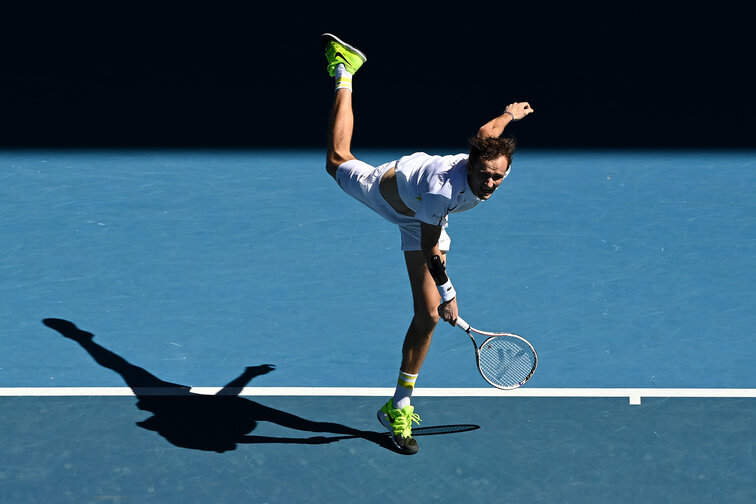When Daniil Medvedev plays corner arithmetic with his opponent
What makes Daniil Medvedev so successful? Our tennis insider will tell you!
by Marco Kühn
last edit:
Feb 09, 2021, 12:18 pm

Imagine the top 20 are a school class. Everyone has their strengths in different disciplines. Alex is damn good at history and paints the coolest cartoon characters. Karen is strong at sports and can do 50 pushups. Novak is the cleverest way to hide his cheat sheets and is a math genius. And then there is someone who goes along with everything inconspicuously. But in the most prestigious game, corner arithmetic, he always knows the right answer. And not only that: He's always the quickest to find this answer.
It's a tear in your hair
When calculating corners, the winner is the one who solves the tasks fastest, leaves the competition behind and is back in his corner. Daniil Medvedev does exactly that on the tennis court. He waits for the opponent's tasks, solves them at lightning speed and then picks up the congratulations on the network. Every opponent makes a headache when he serves the first serve directly on the line three times in a row during his own service game and at 15:30. It must be annoying when he suddenly stands in front of the net even though he hadn't played a volley in the 45 minutes before. We are now examining two steps in the game of the stoic Russian in order to be able to reveal a bit of his secret of success.
The "I watch what you do" formula
The best at corner math already take the sprint posture while the task is still being formulated. Medvedev analyzes his opponent with a similar focus. He crawls into his head, understands his game idea and quickly finds solutions for these ideas. When his opponent tries to avoid the grueling long rallies with net attacks, Medvedev knows after three net attacks where the first volley is going. Anyone who thinks Daniil makes more mistakes on slow slice balls will quickly be taught better. Why Medvedev immediately knows the correct answer to a change of pace, we will clarify in the next section.
In tennis there are players who set the pace themselves. They are the ones who act. These include Dominic Thiem, Roger Federer and Karen Khachanov. Then there are the guys who specialize in reacting to this given pace. These include Novak Djokovic and Daniil Medvedev. You see what the opponent is doing. As soon as they know this, they give playful answers.
Daniil Medvedev is not someone who shoots an opponent off the pitch. He's the one who shoots him off the pitch who wants to shoot him off the pitch. How he practically implements this from his beloved baseline, that's what we'll look at now.
#VIDEO#
Full emotional control
What is the difference between Nick Kyrgios and Daniil Medvedev? Everything. While Kyrgios wants to show off all his creative, playful tricks like a rascal, Medvedev plays the felt ball through the middle for the 19th time without humor. While Nick rolls his eyes, discusses with one of his many personalities or includes the referee in the conversation, Daniil stands bored five meters behind the baseline and awaits the opponent's serve.
This total emotional control, also referred to as "boredom" by some, is one of the greatest strengths in Medvedev's game. This control enables him to play his best tennis. What does this best tennis look like? It mirrors the opponent's game. Djokovic is also very happy to do this. Especially when he is not entirely sure of himself. Medvedev built his entire style of play on this idea. You can say he stole Djokovic.
Now you ask yourself what the mirroring of the opposing game is. Here are some examples from Medvedev's practice:
The opponent quickly plays into Medvedev's backhand. Medvedev quickly plays into the opponent's backhand.
The opponent plays a backhand slice through the middle. Medvedev plays a backhand slice down the middle.
The opponent plays fast and flat. Medvedev plays fast and flat.
The opponent plays half-high, with a lot of spin, on the backhand. Medvedev plays half-high, with a lot of spin, on the backhand.
That would be too easy, wouldn't it? Right. That's why the shrewd Russian added a few more puzzles for the competition to this idea. These puzzles take on the playful form on the court in the form of stops, net attacks, forehand-inside-out bullets and a high variation in serve.
What the hobby player can learn
A conclusion is often boring. So let's see what hobby gamer you can learn from this clever guy. Emotional control is a long-term process. You can find out for yourself what triggers you in the match. The behavior of the opponent? Slight mistakes at the beginning of a match that make you restless? Strong forehands of the opponent that you can hardly control on your stringing?
Find three trigger points. Once you have these, you move on to the next step. You analyze why what triggers you. Those who quickly become insecure have too little self-confidence. Anyone who is upset about the opponent's style of play feels caught in their weaknesses. If you are quickly impressed by the opponent, you speak down to yourself and make your opponent strong at the same time.
Tactically, you can look at Daniil Medvedev's basically simple game idea. Many club players want to implement too much from training in the tournament. They want to make few mistakes, hit a lot of winners and hit 90 percent of their first serves. That is commendable, but unrealistic. It is better to make fewer mistakes than your opponent.
Daniil Medvedev would probably advise you exactly this for your next match.
You can find more from the tennis insider here !
